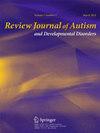求助PDF
{"title":"Teaching Reading Skills to Individuals with Autism and/or Intellectual Disabilities Using Computer-Assisted Instruction: a Systematic Review","authors":"Olivia Kurzeja, Samantha Flynn, Corinna F. Grindle, Daniel Sutherland, Richard P. Hastings","doi":"10.1007/s40489-024-00465-y","DOIUrl":null,"url":null,"abstract":"<p>Reading is an essential life skill that can lead to independence. However, many individuals with autism and/or intellectual disabilities find this skill difficult to acquire. Computer-assisted instruction (CAI) is one approach that combines recommended reading elements (e.g., phonics, fluency, and comprehension) with evidence-based teaching strategies to support the development of reading skills. The first aim of this systematic review (PROSPERO: CRD42021253686) was to identify CAI reading programs and their effectiveness for individuals with autism and/or intellectual disability. A second aim was to evaluate the views and experiences of those with autism and/or intellectual disability, their teachers, and other stakeholders about CAI reading programs. Electronic searches of 7 databases identified a total of 3539 records for review, with 262 full-text articles evaluated, and 47 papers included in the review for data extraction and quality appraisal. The review identified both single-component and multicomponent CAI reading programs that were commercially available interventions (e.g., Headsprout<sup>©</sup>, ABRACADABRA) and bespoke interventions (e.g., personalized e-books). Thirty-four of the 47 studies reported positive outcomes in terms of effectiveness. However, the quality of these studies was often poor, and the description of the interventions was often limited (e.g., rationale for the intervention, who delivered it and how), leading to concerns about the rigor of the evidence base. Stakeholders’ views and experiences were reported in half of the evaluated studies. CAI reading programs were reported as enjoyable and easy to use. They were considered effective by the stakeholders. Further research is needed to develop and explore the effectiveness of CAI reading interventions using rigorous study designs, so that individuals with autism and/or intellectual disability can be provided with access to a wider range of evidence-based reading programs.</p>","PeriodicalId":46647,"journal":{"name":"Review Journal of Autism and Developmental Disorders","volume":"27 1","pages":""},"PeriodicalIF":2.9000,"publicationDate":"2024-05-31","publicationTypes":"Journal Article","fieldsOfStudy":null,"isOpenAccess":false,"openAccessPdf":"","citationCount":"0","resultStr":null,"platform":"Semanticscholar","paperid":null,"PeriodicalName":"Review Journal of Autism and Developmental Disorders","FirstCategoryId":"102","ListUrlMain":"https://doi.org/10.1007/s40489-024-00465-y","RegionNum":3,"RegionCategory":"心理学","ArticlePicture":[],"TitleCN":null,"AbstractTextCN":null,"PMCID":null,"EPubDate":"","PubModel":"","JCR":"Q2","JCRName":"PSYCHOLOGY, DEVELOPMENTAL","Score":null,"Total":0}
引用次数: 0
引用
批量引用
Abstract
Reading is an essential life skill that can lead to independence. However, many individuals with autism and/or intellectual disabilities find this skill difficult to acquire. Computer-assisted instruction (CAI) is one approach that combines recommended reading elements (e.g., phonics, fluency, and comprehension) with evidence-based teaching strategies to support the development of reading skills. The first aim of this systematic review (PROSPERO: CRD42021253686) was to identify CAI reading programs and their effectiveness for individuals with autism and/or intellectual disability. A second aim was to evaluate the views and experiences of those with autism and/or intellectual disability, their teachers, and other stakeholders about CAI reading programs. Electronic searches of 7 databases identified a total of 3539 records for review, with 262 full-text articles evaluated, and 47 papers included in the review for data extraction and quality appraisal. The review identified both single-component and multicomponent CAI reading programs that were commercially available interventions (e.g., Headsprout© , ABRACADABRA) and bespoke interventions (e.g., personalized e-books). Thirty-four of the 47 studies reported positive outcomes in terms of effectiveness. However, the quality of these studies was often poor, and the description of the interventions was often limited (e.g., rationale for the intervention, who delivered it and how), leading to concerns about the rigor of the evidence base. Stakeholders’ views and experiences were reported in half of the evaluated studies. CAI reading programs were reported as enjoyable and easy to use. They were considered effective by the stakeholders. Further research is needed to develop and explore the effectiveness of CAI reading interventions using rigorous study designs, so that individuals with autism and/or intellectual disability can be provided with access to a wider range of evidence-based reading programs.
使用计算机辅助教学教授自闭症和/或智障人士阅读技能:系统综述
阅读是一项基本的生活技能,它可以使人独立。然而,许多患有自闭症和/或智障的人发现这项技能很难掌握。计算机辅助教学(CAI)是一种方法,它将推荐的阅读要素(如语音、流利性和理解能力)与循证教学策略相结合,以支持阅读技能的发展。本系统性综述(PROSPERO:CRD42021253686)的第一个目的是确定 CAI 阅读计划及其对自闭症和/或智障人士的有效性。第二个目的是评估自闭症和/或智障人士、其教师以及其他利益相关者对 CAI 阅读项目的看法和经验。通过对 7 个数据库进行电子检索,共发现了 3539 条审查记录,对 262 篇全文文章进行了评估,并将 47 篇论文纳入审查范围进行数据提取和质量评估。综述确定了单组分和多组分 CAI 阅读计划,其中既有商业干预(如 Headsprout©、ABRACADABRA),也有定制干预(如个性化电子书)。47 项研究中有 34 项报告了积极的效果。然而,这些研究的质量往往很差,对干预措施的描述往往很有限(例如,干预措施的原理、由谁实施以及如何实施),导致人们对证据基础的严谨性产生担忧。半数受评研究报告了利益相关者的观点和经验。据报告,CAI 阅读计划令人愉悦且易于使用。利益相关者认为它们很有效。需要进一步开展研究,利用严格的研究设计来开发和探索 CAI 阅读干预的有效性,从而为自闭症和/或智障人士提供更广泛的循证阅读计划。
本文章由计算机程序翻译,如有差异,请以英文原文为准。



